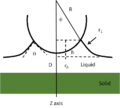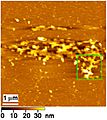Atomic force microscope facts for kids
Atomic force microscopes (AFMs) are special tools that let us see incredibly tiny things. They can even show us individual atoms on a surface! Think of them like super-sensitive fingers that feel the bumps and dips of a material at the atomic level. AFMs are very important in Nanotechnology, which is all about working with materials at a super small scale.
AFMs can do some amazing things that other microscopes can't. For example, they can often show even clearer pictures than a Scanning Electron Microscope (SEM). Plus, AFMs don't need to work in a vacuum, like SEMs do. This means they can look at things in regular air or even in water. This is super helpful for studying living things, like cells, without harming them!
Contents
How an AFM Works: Feeling the Surface
An AFM works using a tiny, sharp needle, like a super-fine stylus. This needle is attached to a small, flexible arm called a cantilever. The very tip of the needle gently scans across the surface of the material you want to see. As the tip moves, it goes up and down over the tiny bumps (ridges) and dips (valleys) on the surface. It's like reading Braille, but on an atomic scale!
As the tip moves up and down, the cantilever arm bends slightly. A laser beam shines on this cantilever. When the cantilever bends, the laser beam changes its angle. A detector then measures these tiny changes in the laser's angle. By tracking how the laser moves, a computer can create a detailed picture of the surface, showing where all the atoms and molecules are.
Different Ways to Use an AFM
There are several ways to operate an AFM, called "modes." Each mode is best for different types of samples.
Contact Mode
In "contact mode," the AFM tip stays in constant touch with the surface as it scans. It simply slides across, and the bending of the cantilever is measured directly. This mode is good for hard, flat surfaces.
Tapping Mode
"Tapping mode" is different because the tip doesn't drag across the surface. Instead, the cantilever vibrates up and down, making the tip "tap" the surface very quickly. It's like a tiny hammer gently tapping the surface. This mode is great for soft or sticky materials, like biological samples, because it's less likely to damage them. When the tip feels a bump, it can lift slightly to avoid hitting the surface too hard.
There are other modes too, like "intermittent contact mode" and "non-contact mode," but they are often variations of these basic contact and tapping methods.
Related pages
Images for kids
-
An AFM image of part of a Golgi apparatus, which is a part of a cell.
See also
 In Spanish: Microscopio de fuerza atómica para niños
In Spanish: Microscopio de fuerza atómica para niños









